Research on Book Drifting Application Based on Mobile Internet
Based on the analysis of the current problems of book drifting, such as lack of certification, lack of integrity, inability to trace, low rebound rate, inconvenient participation, no persistence, etc., this paper proposes to explore the development of book drifting mobile based on mobile Internet and using HTML5, Java and other technologies. New ideas for application. The developed book drifting mobile application can realize online authentication, investment drifting, seeking drifting, drifting, evaluation and reading credit system construction, offline publishing of physical books, book collection and returning books, and personal book management, Read management, idle book transfers, and organizer back-end supervision.
introduction
Bookcrossing originated in Europe in the 1960s. Books are put on the park benches, cafe tables, museum corridors, library stairs, etc. by books. The place is provided to the picked-up person for free; after the reader finishes reading, the book is placed in a public place in the same way, and the next book-lover is read, so that it continues to circulate continuously [1]. In 2004, the word "bookcrossing" was included in the Oxford English Dictionary [2], which became a special term for book drifting.
The earliest book drifting activity in China began in 2004. At that time, the three best-selling books were published by the Spring Breeze Literature and Art Publishing House. Later, the book drifting activities gradually began to rise in cities such as Beijing, Shanghai, Shenzhen and Qingdao. In recent years, with the development of the Internet, book drifting activities have begun to be moved to the Internet, and book drifting websites are constantly appearing.
The main problem of current book drifting
Although the book drifting website has made great progress in drifting the book information than the traditional book drifting, there are still some key problems that the traditional book drifting is difficult to overcome. According to reports, the current global book drifting still has the problem of “three nos and one lowâ€, that is, there is no organization, no system, no persistence, and low rate of return [3]. Domestic book drifting also encounters similar problems in global book drifting. Among them, the problems of high organizational cost, small drifting range, poor quality of floating books, difficulty in sustainability, and low integrity of drifting are more prominent [4][5][6] .
No certification, drifting reading is low
The original intention of the book drifting is to build a bridge for free transfer of knowledge among the readers who are not familiar with each other. "Recognizing the book does not recognize people" and "love is the hand" is the game rule of "book drifting". Since current book drifting is often to ensure participation, there is a lack of accurate identity authentication. Therefore, in the process of drifting, once someone "loves" the drifting books, the drifting process of the book will suddenly end [7]. This lack of identity authentication and binding behavior of the book eventually led to the reduction of good books, the less enthusiasm of the participants, the increased trust crisis between the floating and seeking people, the difficulty in building the fluency of reading and reading. .
Unable to trace, high quality book drift rate is extremely low
There is no traceability and traceability requirements for the existing book drifting. The information of the floating book process is difficult to query and monitor. The execution of the drifting rules is completely dependent on the consciousness of the seeker. The person who floats is “only has the obligation to float and has no rightsâ€. People not only can't find the drifting information of their favorite books, but also lack the "rights" to recall or retrieve their books when necessary [8]. The lack of information traceability and recall mechanism has led to the widespread “high quality book drift rateâ€, which has seriously affected the orderly development of book drifting activities.
Involuntary participation, the development of book drifting is difficult to sustain
The drifting of books is to enable the book lovers to participate in the process of drifting and drifting anytime and anywhere, and the existing book drifting often covers a small scope, complicated procedures, high management costs, inconvenient participation, etc., such as: the most famous books The drifting website, which has more complicated procedures, limited coverage and fixed physical drifting points, is currently limited to a very small number of areas in a very small number of megacities in China, and the effect is not good and difficult to maintain.
On the other hand, many organizers of book drifting in China often focus on what they want to do, and do not pay attention to what the audience wants [7]. Book drifting is often carried out mechanically by the organizer as a reading promotion. These book drifting activities are not limited to a fixed time each year. The books in the book drifting activities are also the public welfare and propaganda activities invested by the organizers [9]. The lack of targeted books, the loss of book assets, the unrecognized target audience, and the input cost. Problems such as high standards have made it difficult to continue the drifting of books.
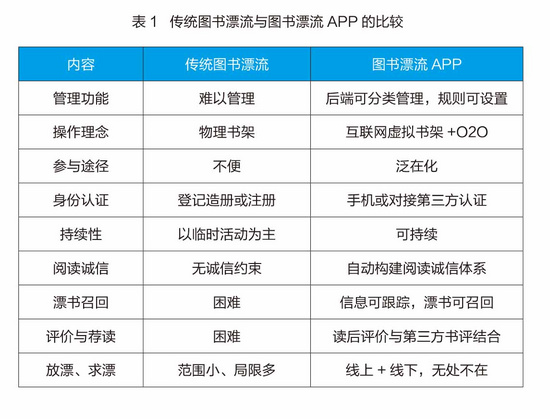
Book drifting mobile application exploration
Feasibility of book drifting mobile application
According to the 38th Statistical Report on Internet Development in China, as of June 2016, the number of mobile Internet users in China reached 656 million, and the proportion of netizens using mobile phones to access the Internet increased from 90.1% at the end of 2015 to 92.5%. Has become the mainstream and trend of Internet applications [10]. Mobile Internet has the advantages of easy participation, ubiquity, traceability, self-organization, and information symmetry. It is precisely the flaw that traditional book drifting is difficult to overcome. Therefore, exploring the use of mobile Internet technology to explore the process of reconstructing books drifting will Brought profound changes to the drifting of books.
According to the literature reports, in recent years, many people at home and abroad have proposed the idea of ​​book drifting based on Internet thinking, and there are also cases of borrowing activities such as QQ and WeChat social platform to assist the book drifting activities [11][12], but there is still no special book drifting. Mobile application products. In 2016, Yang Yan proposed the idea of ​​“O2O Book Drifting†project. The idea is to adopt a combination of online and offline modes to create a mobile terminal for O2O book drifting platform. The method of placing books, taking books, and returning books, realizes zero-cost, zero-collateral, zero-risk self-service self-book exchange activities [13]; Li Wei in 2016 through a wide range of user surveys and analysis, also proposed a social network-based book Feasibility of drifting [14]; Fancheng team of Nanjing University of Posts and Telecommunications also tried the "real person library" App project similar to book sharing.
Based on the analysis of the current situation of book drifting and the key issues, this paper proposes the innovation and development of book drifting application system based on mobile internet (hereinafter referred to as “Book Drifting Appâ€), in order to explore a key constraint factor that can overcome the traditional book drifting. Realize the ubiquitous book drifting mode of mobile terminals that are available to everyone, ready to use, symmetrical information, timely recall, integrity evaluation, and online and offline.
Key issues for the book drifting app
First of all, based on the mobile phone or the introduction of third-party identity authentication and Internet credit evaluation integration mechanism, the book drifting reading integrity system can be conveniently and automatically constructed. Secondly, the transparent identity information between participants and the traceable source of circulation Chain information, as well as post-reading evaluation and third-party evaluation mechanism, can facilitate the timely recall of books drifting and the sorting of the drift rate, which can improve the enthusiasm of the participants, and also promote the “survival of the fittest†of drifting books; App-based mobile participation model can achieve the goalless and zero-cost ubiquity of participants, which not only greatly increases the participation, reduces the input cost of the organization, but also transforms the book drift from the fixed activity of the organizer into The self-organized “lifestyle†of netizens can promote the benign and sustainable development of books drifting.
Book Drifting App Architecture
Logical architecture
The Book Drifting App is based on the concept of “Mobile Internet + Book Driftingâ€. With the help of the e-commerce model, the floating person with the “Book Drifting App†on the mobile side is associated with the drifting person. The whole system is divided into two parts: mobile client and management. Among them, the mobile client is for the participants of the book drifting, while the management terminal is the organizer and rule maker for the book drifting.
The logical architecture of the book drifting app is shown in Figure 1. Among them, the management terminal mainly formulates the rules of identity authentication, virtual bookshelf, circle of books, reading integrity, book drifting, etc., and can supervise the process of book drifting. The user terminal is engaged in registration certification, floating on the shelves, floating book inquiry, information traceability, floating book recall, integrity evaluation and information inquiry, book review, offline procedures, etc., and implementing e-books under the constraints of relevant rules. Online sharing, paper book offline drifting operations, etc.
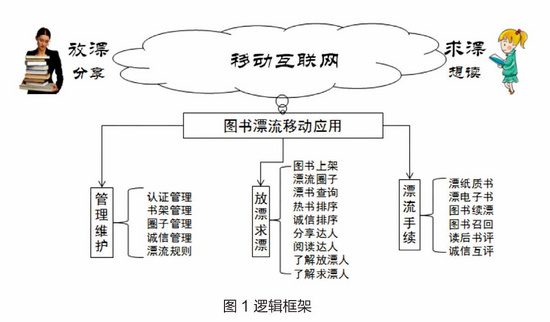
?Technical architecture and implementation
The book drifting mobile application system adopts the B/S-based architecture, the mobile client uses HTML5 and Java tools to develop, and the management terminal uses Java technology combined with the MySQL database system to ensure that the mobile client and the management end have a good experience.
Authentication technology: Basic authentication can be done by mobile phone or by means of WeChat authentication to achieve the non-perception of the participants' no-threshold and use. On the basis of basic authentication, participants can also improve their own information and obtain higher usage rights through real identity confirmation. At the same time, the certification system can also interface with third-party authentication systems, such as the reader library of university libraries, the unified identity authentication system of the community or the unit, to ensure a closer and true relationship between the participants.
Virtual bookshelf construction: The virtual bookshelf is divided into two kinds of floating bookshelves and collection bookshelves. Among them, the floating bookshelf is a bookshelf for people who can ask for and float books, while the bookshelves are reserved for self-reading or small areas. The bookshelves shared by friends, the books between the two bookshelves can be adjusted by the floaters as needed. The book shelf-up process is to release the QR code after scanning the book through the mobile phone or input the ISBN information by itself. The system queries and imports the complete bibliographic information from the third-party platform of the Internet according to ISBN, and the player simply clicks the “confirm†button, and the book automatically Enter the floating bookshelf, and then ask the drifter to check the book shelves and drifting information. When the third-party platform does not have bibliographic information, it can be manually added to the drifting bookshelf.
The process of seeking books and floating books: seeking drifting people to obtain the required floating book information by means of inquiry, sorting of hot books, sorting of drifting rate, sorting of people's reputation, etc., just click the corresponding reservation and ask for a drift button, and ask for a drifting person. A request for a request for a float is issued to the person who floats or the book holder; after receiving the information on the request for the float, the person who is in the float or the book holder can accept or reject the offline paper book exchange according to the reading feedback of the person seeking the float. When the paper book is offline, the person who asks for the transfer will use the QR code after scanning the book with the book drifting App mobile phone. After reading or after a certain period of time, the book will automatically become a reservationable state, so that the next person to ask for a reservation. Once the book owner needs to recall the book, the book will be automatically removed and the reader will be notified to return the book in time.
Afterwards, the person who asks for the float can evaluate the book, and the person who floats and floats can also score each other. This score will automatically become the reading credit score of the drifting participants, and will become the reading credit rating of the corresponding participants in the book drifting platform. .
Application development
The book drifting mobile application system has been supported by the “Xaar Network Next Generation Internet Technology Innovation Projectâ€. After preliminary research and development, the system has been initially completed. For the convenience of users, two applications based on WeChat and App have been developed. Among them, the WeChat application has been online for more than 3 months, with nearly 500 registered users and more than 300 floating bookshelves, providing experience and data support for App application development. The following mainly introduces the book drifting app system.
Figure 2 shows the first page and the personal center page. The home page refers to the “Share Bike†page. It only displays the functions of scanning code, book search, and personal center shortcut channel. It is simple and easy to use. By clicking the first page to scan the book, it opens the phone. The code function is convenient for appointments or for those who do not have reservations. Figure 3 shows the Add Book and My Book interface. On the My Book interface, you can see the "Floating" and "Reading" status of the book. Among them, "In the drift" indicates that you can make an appointment, and "Reading" instructions. Someone is reading. FIG. 4 is a search for a search and a sorting list interface in the floating book. As long as the search bar of the first page is clicked, an appointment, a recommended book may appear, or a designated book in the keyword search system may be directly input. Based on the theory of "mobile Internet + book drifting", there is no geographical limitation. It can be used in universities, regions, countries and other fields. It will better explore the resources of netizens and enhance the ability of knowledge sharing, which is conducive to the promotion of the construction of scholarly society.
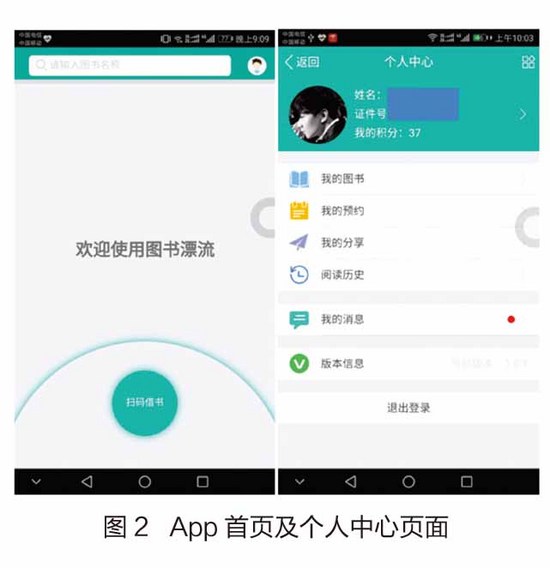
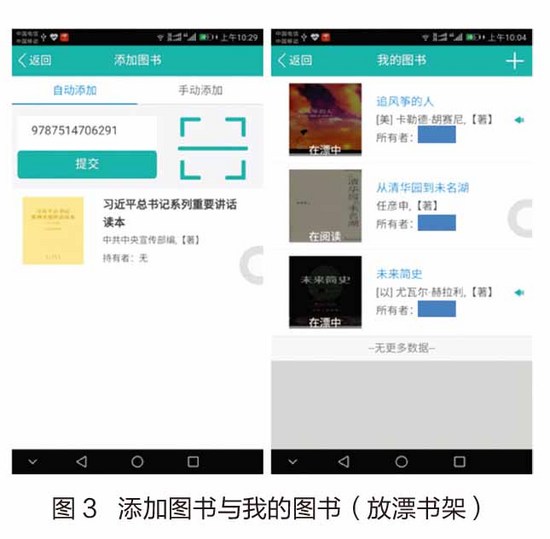
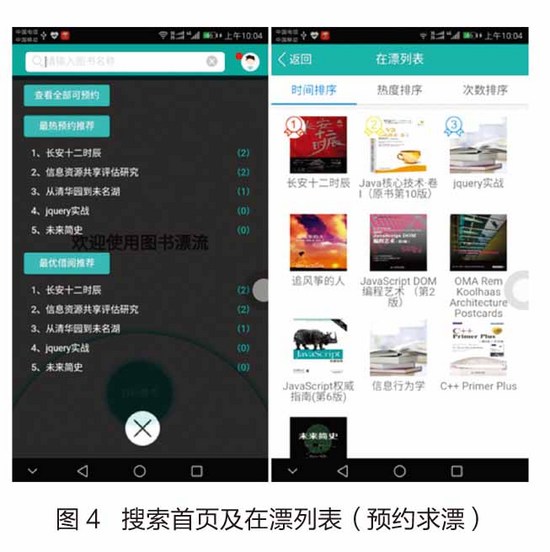
Conclusion
The book drifting mobile application is also a “mobile internet + personal libraryâ€. In addition to the book drifting function, in the future, it can extend the features of the book shelf, book community, online book review, book transfer, reading integrity, etc., so that it gradually becomes a participant's individual. The library management center and reading center have positive significance for promoting "reading by all people" and promoting knowledge and excellent cultural communication in China.
(The author's unit, Cha Guiting, is the library and information center of Nanjing Agricultural University; Zheng Yi Zhang Jingzheng is the College of Information Technology, Nanjing Agricultural University)
Fund Project: This article is supported by Xaar Network's next-generation Internet technology innovation project, project number NGII20161101
references
[1] Guo Hongchang. Global “Rafting Library†[J]. Journal of Academic Libraries, 2005. No. 2: 24-27
[2] Lei Lei. Watching book drifting [J]. Library and Information Work, 2007.2. No. 51: 139-141
[3] Zhuang Wei. Freedom - Sharing - Reading: Floating Book Movement in Taiwan [J]. National New Book Information Monthly, 2013.11 No.179:4-8
[4] Zhao Hong. Research on the Problem and Management Model of Book Drifting in Colleges and Universities[J]. Library Work and Study,2014.7:43-46
[5]Chen Minfang, Ji Hongbin. Deepening Path of Campus “Book Drifting†Service[J]. Library Journal, 2016.No.4:48-64
[6] Zhou Wenqi, Li Zanmei, Hu Dehua. Investigation and Analysis of Book Drifting Websites in China[J]. Library Work Research, 2011.3.No.5:90- 94
[7] Liang Chaoye. “Book drifting†should not focus on what to do but what to focus on [N]. Youth Daily, November 22, 2016
[8] Zhao Qing, Ling Dongmei, Lv Zhujun. Relying on the Internet Community to Realize the New Model of Book Drifting[J]. Library Journal, 2012.No.10:56- 60
[9] E Lijun. Investigation and Analysis of Book Drifting Activities in University Libraries[J]. LIBRARY JOURNAL, 2016.No.4:43-47
[10] Yang Jie. Wireless network: will eventually become the future of campus network [J]. China Education Network. 2017.1:41
[11] Jiang Lixia, Zhang Jianli. Based on QQ group, the practice of children's books drifting in the same city[J]. 新世纪图书馆, 2014.No.8:58-60
[12] Ou Xiaojing. Participating in the “Book Drifting†WeChat can borrow books [N]. Guicheng Community News, 2016.12.7:7
[13] Yang Yan. Conception and Analysis of the Implementation of “O2O Book Drifting†Project in Library[J]. Management Review, 2016.8.No.24:144-146
[14] Li Wei. The Sustainable Development of Book Drifting from the Behavior of Social Network Users in Colleges and Universities[J]. Library Research, 2016.6: 62-65
Staff lockers give employees spaces to keep their belongings safe during the working time.
It also helps them stay connected to the business and makes them feel more valued.
Lockers for hospital staff help them to take care of themselves to provide the best care for others.Metal Drawers are also popular in hospital daily storage.
Law enforcement officials may need vented Metal Lockers and Standard Metal Lockers to store duty bags, evidence, records, uniforms, and more.
In the hospitality trade, hotels need to arrange lockers for their employees to secure their belongings during a shift.
Whatever you need staff lockers for sale online for hospitals, hotels,or government institutions, you come to the right place.
Staff Lockers for Sale,Lockers for Workplace,Cheap Staff Lockers
LUOYANG SHIDIU IMPORT AND EXPORT CO., LTD , https://www.shidiucabinetes.com